Solar facades
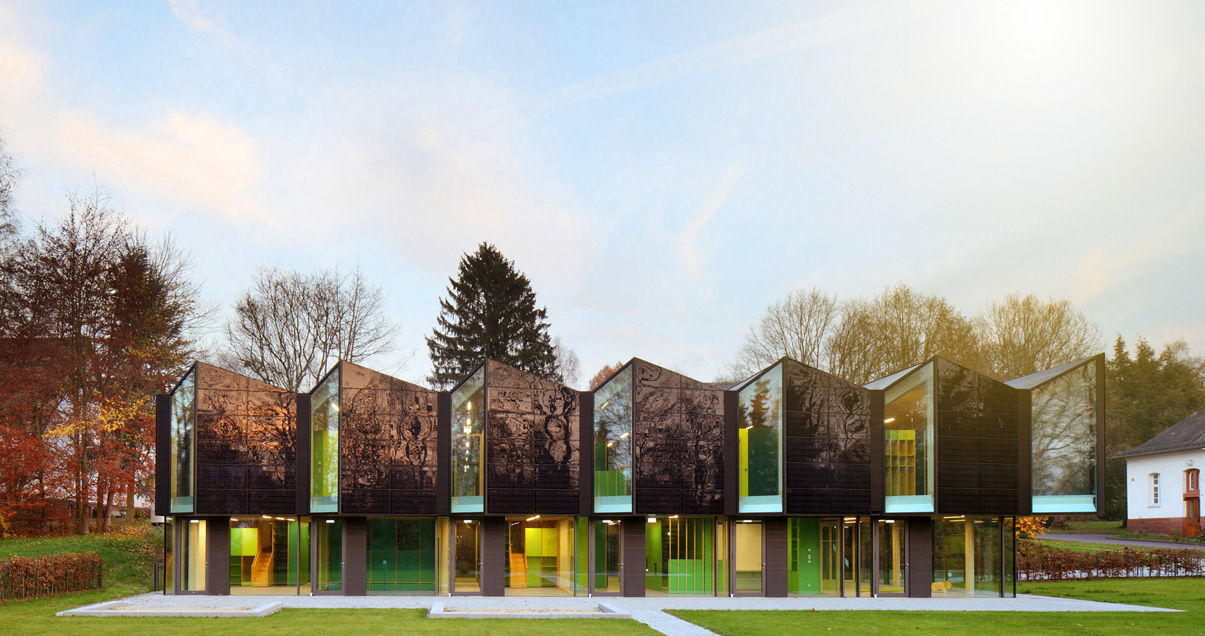 © Eibe Sönnecken, opus Architekten BDA
© Eibe Sönnecken, opus Architekten BDAFor most people, the word “photovoltaics” conjures up images of shimmering blue panels on single-family homes or open spaces next to the highway. In fact, around three quarters of the PV modules in Germany are installed on roofs and one quarter on the ground. However, that leaves lots of unused space for vast amounts of clean electricity where you might least expect it: in the vertical plane.
Renewable energies to the fore
PV systems on roofs and in open spaces only work when there are enough of them. However, downtown high-rises and multi-story office and residential buildings do not have large enough roofs to supply electricity, let alone produce it. No wonder all eyes are on façades.
“Building surfaces offer huge opportunities to use the built environment to produce renewable energy on-site. Our goal is to protect the land and countryside while upgrading the buildings in the EU and delivering on the European Green Deal, which has targeted on-site production of electricity as a key strategy for exiting the carbon age,” said Pierluigi Bonomo of the Institute for Applied Sustainability in the Built Environment at the University of Applied Sciences and Arts of Southern Switzerland (SUPSI).
Façade-mounted solar panels are 20 to 30 percent less efficient than roof-mounted ones depending on the solar irradiation. However, this disadvantage is offset by the much larger area offered by façades on multi-level buildings. Also, as the sun dips lower during the year, it irradiates more of south-facing façades than roof areas.
“Performance optimization is particularly important for solar façades because parts of the system will be shaded at times. SMA makes inverters featuring integrated yield optimization instead of conventional module optimizers, which are essentially electronic controllers for each individual module. With integrated yield optimization, the inverters seek out the point that currently has the highest output on the entire surface, which makes it possible to use almost all the energy supplied by the PV modules,” said Hannes Knopf, Senior Expert Standards & Committee Work at SMA.
Solar range
Typical solar roofs with their utilitarian panels may be a marvel of technology but fall short aesthetically. That makes it surprising that ambitious designers and architects all over the world have created true gems ever since it became possible – or rather necessary – to generate solar power on building walls.
Pierluigi Bonomo sees in the transfer of PV to buildings, including roofs, façades, and accessory systems, a tangible cause of innovation in contemporary architecture and PV today. “It is much more than an energy or technical possibility: it is a new fundamental in building aesthetics, ethics, and technology.”
There are three basic approaches. On some buildings, PV panels are recognizable as such but simply act as a neutral design element. Other buildings do not offer even the slightest hint that their façades generate electricity. The PV modules are so cleverly integrated that they could be glass or another façade material. Occasionally, PV modules serve several purposes such as a sunshade. Finally, there are proud façades that deliberately put modules on display, shouting from the rooftops – or, rather, façades – that “solar is cool!”.
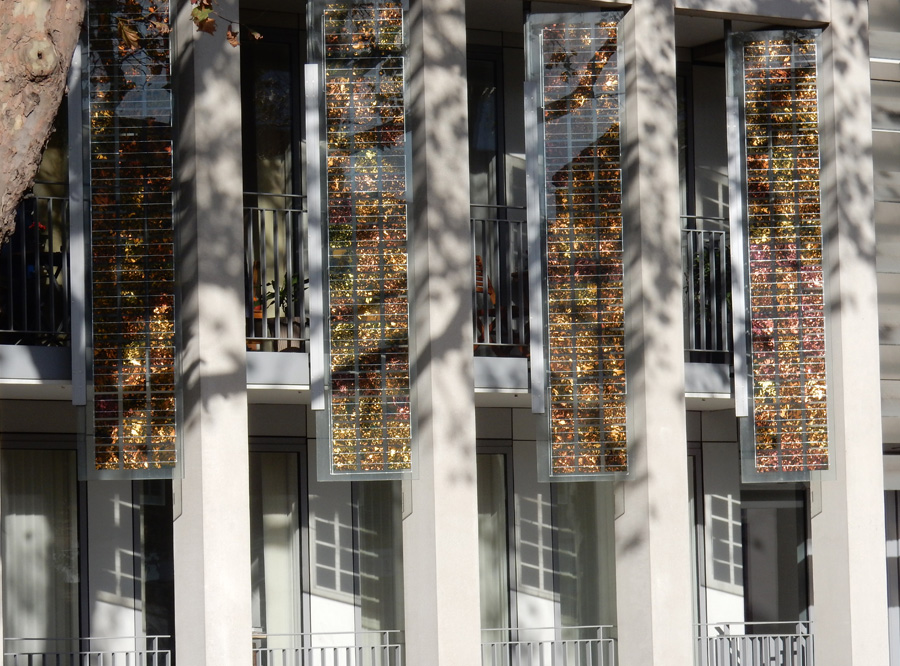 © Kingsgate House, London (Photo: P. Bonomo)
© Kingsgate House, London (Photo: P. Bonomo)
Crystal-clear advantages
Conventional PV modules consist of crystalline PV cells enclosed in a plastic or resin layer, an aluminum frame and a glass cover. They are the preferred option for directly irradiated areas such as pitched roofs. However, they also quickly pay for themselves when installed on a south-facing building wall. The lower yield due to shorter solar irradiation periods can be offset by increasing the usable area.
The surface of crystal PV cells has a bluish, dark-blue or matte-black appearance depending on how they are made. The modules are also rigidly built. Both characteristics seem to leave little leeway for creativity in façade design. However, these restrictions do not have to be an obstacle for imaginative minds.
Flexible elegance
Thin-film solar cells have an even thinner solar active layer than crystalline cells. That allows them to be laminated between flexible materials (usually plastic sheets) and bent. This technology inspired high hopes for some time. It seemed predestined for façades – architects could let their imaginations run wild in mounting these cells on curved surfaces and choosing color schemes.
However, none of these expectations materialized, and flexible thin-film modules have not become widely adopted as a building material, as confirmed by Dr. Friedrich Kessler, who researches flexible PV cells and modules at the Center for Solar Energy and Hydrogen Research Baden-Württemberg (ZSW). “There are some use cases today, but they tend to be rather unusual projects.” He believes their real future will be in mobile or temporary applications, which are still niche markets: “For example, you can roll thin-film modules out on greenhouses in the summer. They provide emission-free electricity while shading the soil and protecting it from drying out. Agrivoltaics is starting to spread successfully. Other applications include the recreational and automotive domain – anywhere mobility and/or light weight are required.”
Interestingly, architects’ and planners’ attitudes toward crystalline PV cells seem to have shifted dramatically as climate awareness has grown: Modules that used to be unsentimentally pre-assembled or hidden are now put on display: Look here, I’m producing renewable energy! Visible solar architecture seems to be trending towards crystalline PV modules, the blue shimmering rigid panels.
Utilitarian productivity
In retrofit projects, classic PV modules are usually hung on rails in front of a wall with a few centimeters of clearance so air can circulate. Most property owners choose retrofitting so their building will have an on-site supply of renewable energy. However, even this utilitarian solution has aesthetically beautiful examples.
The Rhein-Kai-Speicher 7 building in Mannheim, Germany, generates more energy with its large-scale PV system than it consumes. That makes it an energy-plus building.
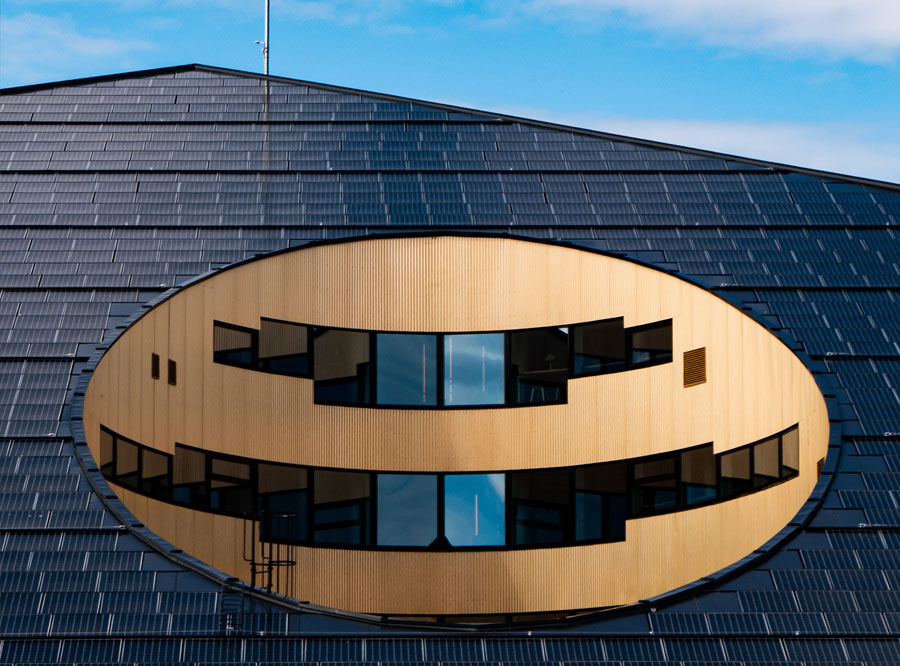
Invisible power plant
Wohnhaus Solaris is a multi-family home built on Lake Zurich by Adrian Berger, Erika Fries, and Lukas Huggenberger in 2018. The architects’ goal was to make Wohnhaus Solaris‘s PV systems invisible. Easier said than done – the façade’s printed and structured cast glass had to let as much sunlight as possible into its integrated PV cells to make the photovoltaics pay off.
Laminated glass modules have made tremendous progress in just a few years. People who want PV cells that produce electricity incognito in the façade now have plenty of design options.
The façades of this residential building in Zurich are completely covered by PV modules that produce more electricity than the house and its residents consume. The façade cladding modules feature check-patterned digital ceramic printing to avoid a “technoid” look.
In a project in Watford, London, ÜserHuus AG, a spinoff of the Lucerne University of Applied Sciences and Arts, added to the façade a horizontal band of PV modules colored like the materials behind them – wood, metal, and fiber cement. The modules were the product of special digital color printing on glass and ultra-efficient monocrystalline PV technology.
The right angle
Modules must be aligned as precisely as possible with the sun to get the maximum energy yield from crystalline solar cells. The new city hall in the German city of Freiburg showcases how far photovoltaics can go: 880 PV modules weighing 100 kilograms each are installed on metal elements along a curved façade, covering over 13,000 square meters. The solar roof and façade combined supply the building and its users with 100 percent of their own electricity.
Doubly useful
PV modules that are not retrofitted or added on but actually perform a function in a building’s structure are known as building-integrated photovoltaics, or BIPV for short. In this case, solar technology serves as a construction material that protects the façade and residents from wind and weather, shades or soundproofs a building while looking beautiful.
„By assuming both the function of energy generators and of construction materials, BIPV are of particular interest in the context of decarbonizing energy systems, especially in densely built European environments where traditional ground-mounted photovoltaic (BAPV) systems cannot be easily used.“
– Emmanuel Rey
Architects increasingly include solar façades as a structural and design element in new construction from the start. Integrated solar façades serve as conventional façades or façade cladding and generate electricity, which may even cut building costs.
„Today, BIPV has achieved a high level of technical maturity.“, explains Pierluigi Bonomo, who, in addition to having the scientific lead of the BIPV team at the Institute for Applied Sustainability in the Built Environment (SUPSI), works for the International Energy Agency on the framework conditions for the development of BIPV. Meanwhile architects, building owners, façade constructors and real estate developers find “a diversified range of products, which can be manufactured and customized like any conventional building envelope solution.“
In any case, rising interest and demand for climate-friendly electricity have clearly spawned a host of new technologies and design concepts for integrated solar façades.
One obvious option is to use classic PV modules as a source of shade – their dark coloring blocks much of the sunlight.
Kühne Kontur
The solar system itself defines the contours of the building in some solar façades. “The low-resource energy generation system is displayed on the outside of the sculptural façade made of photovoltaic elements, thus giving the building an unmistakable character.” This is how the architects of kadawittfeldarchitektur describe their energy efficiency center on the campus of Hochschule Niederrhein in Mönchengladbach, Germany.
The solar façade of the Solar daycare center in Marburg designed by opus Architekten in Darmstadt, Germany, also looks folded. On a side note, monocrystalline silicon cells were installed in this project in black laminated safety glass.
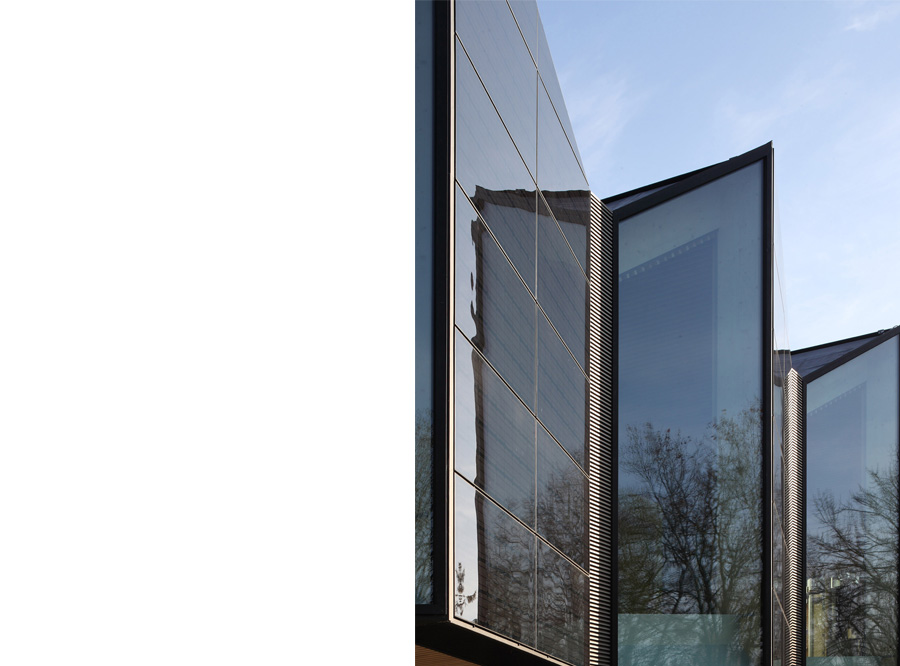 © Eibe Sönnecken, opus Architekten BDA
© Eibe Sönnecken, opus Architekten BDA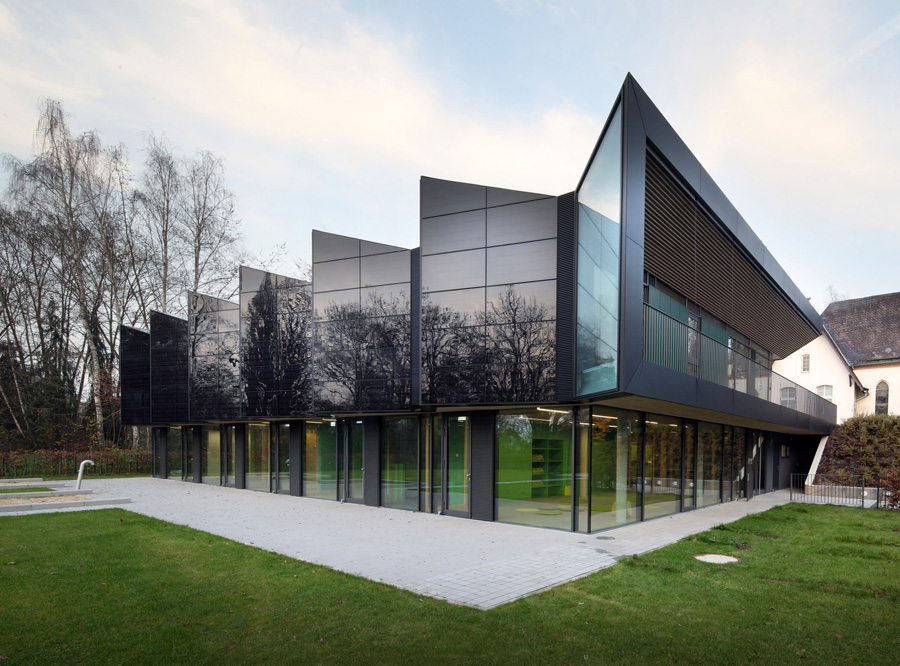 © Eibe Sönnecken, opus Architekten BDA
© Eibe Sönnecken, opus Architekten BDAWhat comes next …
Pierluigi Bonomo sees a significant competitive opportunity for Europe in the development and establishment of building-integrated photovoltaics. Now that many hurdles have been overcome and a number of problems have been solved over the past few years, the BIPV researcher believes that the greatest challenge at present is to “widely demonstrate BIPV in real buildings with a turnkey solution and an efficient process able to ensure performance, reliability, durability and replicability in a cost competitive way.“
This is also what Prof. Emmanuel Rey is working on. Prof. Rey is the head of the Laboratory of Architecture and Sustainable Technologies (LAST) of the Ecole polytechnique fédérale de Lausanne (EPFL) and maintains a partnership with the architectural design firm Bauart in Bern, Neuchâtel and Zurich, Switzerland. He has researched the hurdles that stand in the way of mass adoption of BIPV. Aside from high initial costs and high complexity compared to conventional construction materials, he says that there is a low awareness of BIPV among the general public and the reluctance of a majority of architects to implement BIPV in their designs.
This is compounded by institutional barriers, such as the lack of building codes and standards or their non-uniformity from country to country, in particular for PV façade elements, which increases the perceived risk of using novel technologies in the traditionally conservative construction sector.
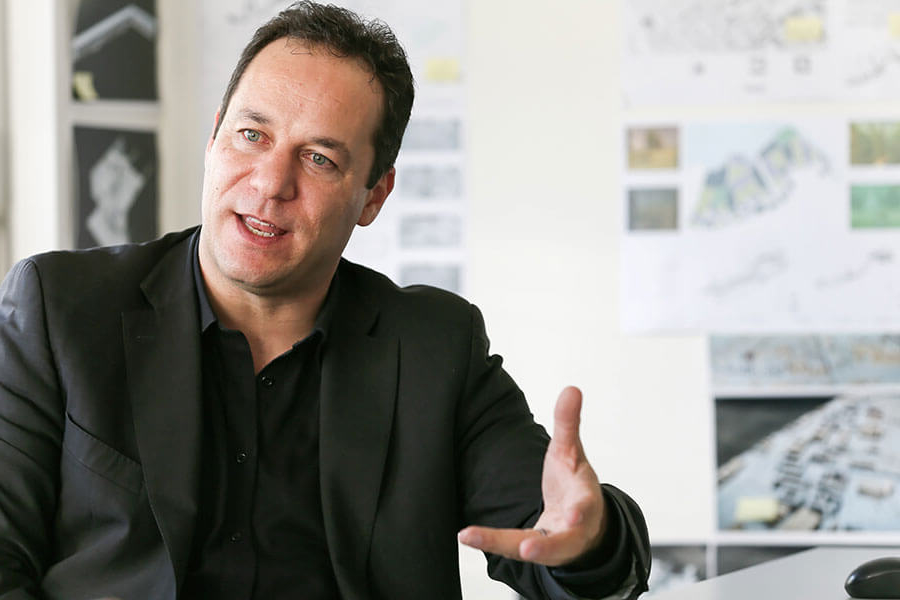 Photo: Alain Herzog
Photo: Alain Herzog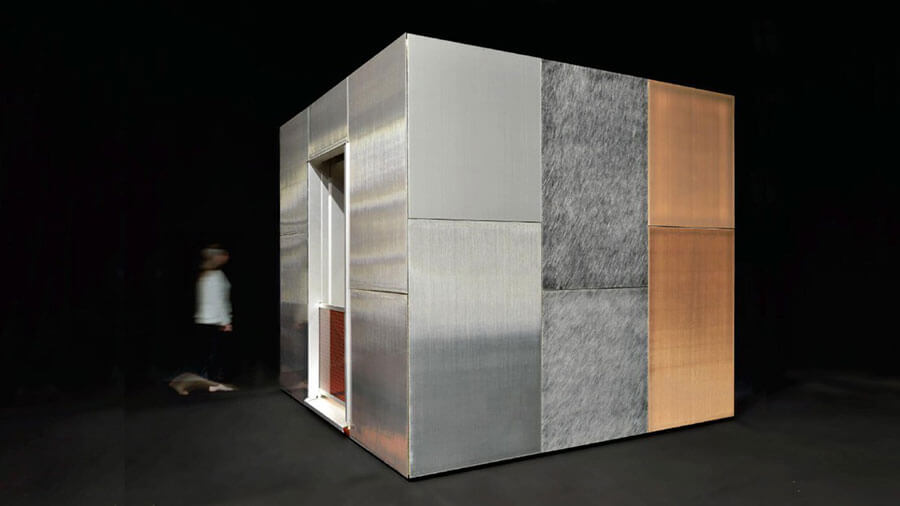
A team led by Emmanuel Rey has been working on integrating BIPV into urban renewal processes in an interdisciplinary research project called ACTIVE INTERFACES: “The case studies demonstrated that renovation projects using BIPV were economically feasible, environmentally effective and allowed a wide range of possible architectural expressions, including different colors and textures.”
The team developed an Advanced Active Façade with support from the Swiss National Science Foundation (NSF) as part of the “Energy Transition” National Research Program: This novel construction system for low-carbon active façades is designed as a self-supporting, prefabricated wood skeleton on which a coating is mounted on the inside and cellulose-based thermal insulation and customized active PV panels on the outside.
What role will building-integrated photovoltaics play in the future? Pierluigi Bonomo dares to look ahead:
„The building sector is typically perceived as the industry with the longest response times to innovations. However, revolutionary waves have existed in construction sector. Today’s wave is linked to a sustainable transition, thanks to an alliance between public policies, research and industrial efforts as well as common will. Many visions and scenarios describe how buildings in our cities could look and function in relation to future cities, urban infrastructures and urbanization.“, says Pierluigi Bonomo. “Climate change, the post-pandemic world, digitization or new mobility will frame a combination of strategies. Photovoltaic power is only one of the variables, but it will shape the future of buildings.“
In any case, the sheer variety of current projects and active research on solar façades and BIPV prove that photovoltaics is just at the start of its evolution.

